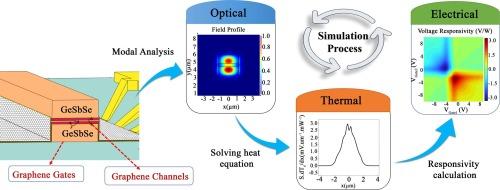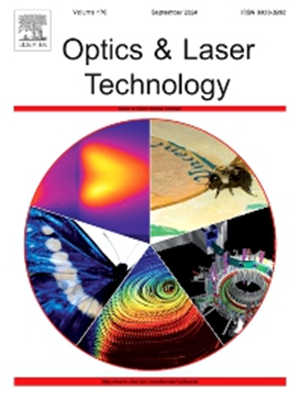High responsivity zero-biased Mid-IR graphene photodetector based on chalcogenide glass waveguide
IF 4.6
2区 物理与天体物理
Q1 OPTICS
引用次数: 0
Abstract
Graphene’s unique properties have made it a promising material for high-performance photodetectors due to its interesting features including broadband absorption, fast speed, and strong photothermoelectric effect. Here, an optimized waveguide photodetector incorporating double graphene layers with two cores is presented to boost the responsivity (∼twice), at Mid-IR range. The proposed structure operates in the zero-bias regime to eliminate the dark current issue associated with the zero bandgap nature of graphene and leads to lower noise equivalent power. The presented photodetector operating based on split gates to electrostatically induce the p-n junction in graphene channels, operates based on the photothermoelectric effect and provides responsivity, NEP, and 3 dB bandwidth of 6.3 V/W, 0.34 nW/Hz1/2, and 1.54 GHz, respectively for the detection at λ = 5.2 μm. The feasibility of the proposed structure is proved according to recent experimentally demonstrated photodetectors. Hence, the obtained results are reliable, in practice. The study has been accomplished by numerical simulation of mode profiles and solving the heat equation to extract the characteristics of the proposed photodetector. The zero-power consumption and tunability of the proposed structure make it a promising candidate for sensing, industrial, defense, and environmental monitoring applications with high accuracy.

基于铬化玻璃波导的高响应度零偏压中红外石墨烯光电探测器
石墨烯具有宽带吸收、速度快和光热电效应强等有趣特性,其独特的性能使其成为一种很有前途的高性能光电探测器材料。本文介绍了一种优化的波导光电探测器,其中包含双核双石墨烯层,可提高中红外波段的响应率(两倍)。所提出的结构在零偏压状态下工作,消除了与石墨烯零带隙特性相关的暗电流问题,并降低了噪声等效功率。所提出的光电探测器基于分路栅极在石墨烯通道中静电诱导 p-n 结,并基于光热电效应运行,在 λ = 5.2 μm 时的检测响应率、NEP 和 3 dB 带宽分别为 6.3 V/W、0.34 nW/Hz1/2 和 1.54 GHz。根据最近实验证明的光电探测器,证明了所提结构的可行性。因此,所获得的结果在实践中是可靠的。这项研究是通过对模式剖面进行数值模拟和求解热方程来提取拟议光电探测器的特性完成的。所提出结构的零功耗和可调谐性使其成为传感、工业、国防和高精度环境监测应用的理想候选器件。
本文章由计算机程序翻译,如有差异,请以英文原文为准。
求助全文
约1分钟内获得全文
求助全文
来源期刊
CiteScore
8.50
自引率
10.00%
发文量
1060
审稿时长
3.4 months
期刊介绍:
Optics & Laser Technology aims to provide a vehicle for the publication of a broad range of high quality research and review papers in those fields of scientific and engineering research appertaining to the development and application of the technology of optics and lasers. Papers describing original work in these areas are submitted to rigorous refereeing prior to acceptance for publication.
The scope of Optics & Laser Technology encompasses, but is not restricted to, the following areas:
•development in all types of lasers
•developments in optoelectronic devices and photonics
•developments in new photonics and optical concepts
•developments in conventional optics, optical instruments and components
•techniques of optical metrology, including interferometry and optical fibre sensors
•LIDAR and other non-contact optical measurement techniques, including optical methods in heat and fluid flow
•applications of lasers to materials processing, optical NDT display (including holography) and optical communication
•research and development in the field of laser safety including studies of hazards resulting from the applications of lasers (laser safety, hazards of laser fume)
•developments in optical computing and optical information processing
•developments in new optical materials
•developments in new optical characterization methods and techniques
•developments in quantum optics
•developments in light assisted micro and nanofabrication methods and techniques
•developments in nanophotonics and biophotonics
•developments in imaging processing and systems

 求助内容:
求助内容: 应助结果提醒方式:
应助结果提醒方式:


